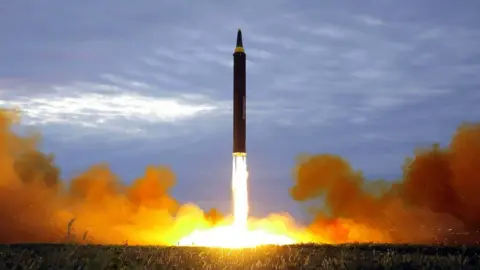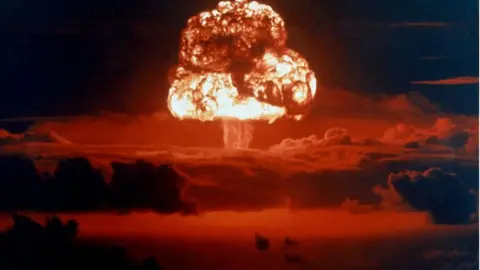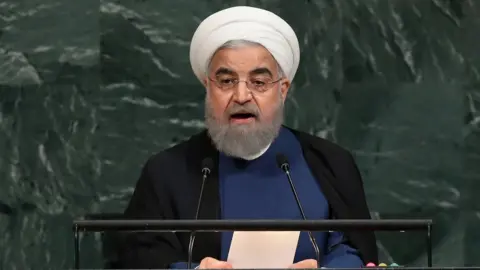Nuclear weapons: Which countries have them and how many are there?
 Getty Images
Getty ImagesWith recent tensions between the US and Iran, you might be hearing a fair bit about nuclear weapons.
They are considered the most destructive weapons in the world - their explosions are so powerful, just one nuclear bomb could destroy an entire city.
Nukes, as nuclear weapons are known, are far more damaging than even the biggest normal, non-nuclear bombs.
There's also been lots of talk about some countries, including Iran, not being allowed to have them, while others can.
There's quite a lot to get your head around when it comes to nuclear weapons - but don't worry, we've put together a guide to the key questions.
What are nuclear weapons?
They are extremely powerful explosives.
You might remember the words atoms and isotopes from science lessons - they're involved in the process of triggering a nuclear blast.
The bombs get their energy from either splitting atoms or joining the tiny particles inside the atoms together. That's also why a nuclear bomb is sometimes called an atomic bomb.
 Getty Images
Getty ImagesNuclear weapons release huge amounts of radiation - which can cause radiation sickness - so their actual impact lasts longer than the blast.
But they've only ever been used twice in history - against Japan in 1945 during World War Two where they caused huge devastation and enormous loss of life.
The radiation from the bomb dropped on the city of Hiroshima lasted several months and killed an estimated 80,000 people.
And the bomb dropped on Nagasaki killed more than 70,000 people.
They haven't been detonated in war since then.
Nine countries currently have nuclear weapons: the US, UK, Russia, France, China, India, Pakistan, Israel and North Korea.
Who can develop them?
In theory, pretty much anyone with the technology, intelligence and facilities.
But whether countries are allowed to or not? That's a whole other issue.
This is because of something called the Treaty on the Non-Proliferation of Nuclear Weapons (NPT) - an agreement which aims to prevent the spread of nuclear weapons and promote disarmament.
 Getty Images
Getty ImagesSince 1970, 191 states including the US, Russia, UK, France and China have joined the NPT. These five countries are called nuclear-weapon states - and are allowed to have weapons because they built and tested a nuclear explosive device before the treaty came into effect on 1 January 1967.
Even though these countries have nuclear weapons, under the agreement, they have to reduce how many they have and can't keep them forever.
Israel (which has never confirmed or denies the existence of its nukes), India and Pakistan have never joined the NPT, and North Korea left in 2003.
So where does Iran fit in?
Iran started its nuclear programme in the 1950s and has always insisted its nuclear energy programme is peaceful.
But there have been suspicions it was being used as a cover to develop nuclear weapons, which prompted the UN Security Council, US and EU to impose crippling sanctions from 2010.
This led to an agreement in 2015 between Iran and other big powers, in which Iran signed a deal to scale back its nuclear energy programme in exchange for trade, but President Donald Trump pulled out of the deal in May 2018.
 Getty Images
Getty ImagesAnd now European countries have challenged Iran for not following the terms of the deal.
And after the escalating tensions between Iran and the US this year, President Trump has pledged that as long as he is president, Iran will not be allowed to have nuclear weapons.
After increased tensions over the killing of Iranian General Qasem Soleimani by the US in Baghdad, Iran has said it's not going to follow the restrictions imposed by the deal anymore.
Will we ever see a nuke-free world?
The number of nuclear weapons in the world is actually down from 70,000 in 1986 to around 14,000 today.
The US, UK and Russia have all been reducing their stockpiles, but China, Pakistan, India and North Korea are believed to be producing more, according to the Federation of American Scientists.
 Getty Images
Getty ImagesIn July 2017, it looked as though the world was a step closer to becoming nuclear weapon free when more than 100 countries endorsed a UN treaty to ban them altogether.
But countries with nuclear weapons such as the US, UK, France and Russia boycotted the treaty.
The UK and France have said the agreement didn't take into account the realities of international security - and nuclear deterrence has been important to keeping peace for more than 70 years.
While countries like the UK and US are reducing their nuclear stockpile, experts say they are still modernising and upgrading their existing armoury.
The UK is upgrading its nuclear weapons systems, and the US may spend more than $1 trillion (£703bn) by the 2040s upgrading its nuclear capabilities.
And North Korea continues to test and develop its nuclear programme with missile tests as recent as October.
So while the world may have fewer nukes today than it did 30 years ago, it doesn't look like you'll be seeing a complete end any time soon.


